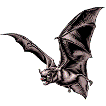Museum, University of Nebraska State

University of Nebraska State Museum: Mammalogy Papers
Document Type
Article
Date of this Version
10-3-2012
Citation
PLoS ONE 7(10): e46578. DOI: 10.1371/journal.pone.0046578.
Abstract
Background: Cryptic morphological variation in the Chiropteran genus Myotis limits the understanding of species boundaries and species richness within the genus. Several authors have suggested that it is likely there are unrecognized species-level lineages of Myotis in the Neotropics. This study provides an assessment of the diversity in New World Myotis by analyzing cytochrome-b gene variation from an expansive sample ranging throughout North, Central, and South America. We provide baseline genetic data for researchers investigating phylogeographic and phylogenetic patterns of Myotis in these regions, with an emphasis on South America.
Methodology and Principal Findings: Cytochrome-b sequences were generated and phylogenetically analyzed from 215 specimens, providing DNA sequence data for the most species of New World Myotis to date. Based on genetic data in our sample, and on comparisons with available DNA sequence data from GenBank, we estimate the number of species-level genetic lineages in South America alone to be at least 18, rather than the 15, species currently recognized.
Conclusions: Our findings provide evidence that the perception of lower species richness in South American Myotis is largely due to a combination of cryptic morphological variation and insufficient sampling coverage in genetic-based systematic studies. A more accurate assessment of the level of diversity and species richness in New World Myotis is not only helpful for delimiting species boundaries, but also for understanding evolutionary processes within this globally distributed bat genus.
Included in
Biodiversity Commons, Other Ecology and Evolutionary Biology Commons, Other Genetics and Genomics Commons, Zoology Commons


Comments
Copyright 2012, the authors. This is an open-access article distributed under the terms of a Creative Commons Attribution License.